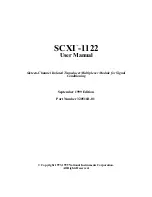
4
4.2 DC VOLTS
V
WARNING
To avoid personal injury or damage to the Meter, do not attempt to measure voltages higher than 1000V
DC.
There are five ranges for measuring DC voltage, 400mV, 4V, 40V, 400V and 1000V. For more accurate measurements
use the lowest range possible without exceeding the voltage setting.
1. Set the function/range switch to the appropriate
V
DC range.
2. Insert the black (negative) test lead into the COM inputterminal.
3. Insert the red (positive) test lead into the V input terminal.
4. Touch the test leads to the circuit under test. With DC voltage, the polarity of the test leads is a factor. Touch the black
(common) test lead to the negative DC source (ground) first and red (positive) test lead to the “live” source second.
5. Read the value of the measurement displayed. If the leads are reversed a “-“ indicator will appear on the display.
6. Typical DC Voltage measurements include car batteries, motors, automotive switches and household batteries.
~
4.3 AC OR DC AMPS A
V
WARNING
To avoid possible damage to the Meter or to the equipment under test, check the Meter’s fuses before
measuring current. Use the proper terminals, function, and range for the measurement. Never place the test
leads in parallel with any circuit or component when the leads are plugged into the current terminals.
WARNING
Do not attempt to measure current exceeding 10Amps AC or DC. If you are not sure if the current exceeds
10Amps do not attempt to measure current with this meter.
There are three positions on the meter for measuring current: A~ , mA~ or,
µ
A~ . The A~ position has a 4.0 A and
a 10A range and is auto ranging. Start with this 10A setting if the measured current is between 1A-10A. Use the mA~
setting if the measured current is
≤
400mA. Use the
µ
A setting if the measured current is <4000
µ
A.
1. Set the rotary switch to A~ , mA~ or,
µ
A~
2. Insert the black test lead into the COM input terminal.
3. Insert the red test lead into the 10A max terminal.
4. DC Amp measurement is the default. Press SELECT if ~AC Amp measurement mode is desired.
5. Turn off power to the circuit to be measured.
6. Open the circuit to be measured.
7. Touch the red test lead to the positive side of the break in circuit and the black test lead to the negative side of the
break in circuit for DC Amp measurement. For AC Amp measurement the polarity of the leads does not matter.
8. Return power to the circuit.
9. Read the amps on the display.
Notes: When measuring AC Amps this meter displays the mean (sine wave effective value).
When the measured current is <5 amps continuous measurement is acceptable.
WARNING
When the measured current is 5-10 amps do not exceed 10 seconds of continuous measurement. Wait 15
minutes between current measurements when measured current is between 5-10 amps.
Always start with the highest A~ Measurement range and reduce the range in steps once you know that the current does
not exceed the next lower range. Once the measurement is complete, immediately remove the test leads from the circuit
under test and remove the test leads from the input terminals of the meter.
4.4 RESISTANCE
Ω
WARNING
To avoid damages to the Meter or to the devices under test, disconnect circuit power and discharge all the
high-voltage capacitors before measuring resistance.
WARNING
Do not input 60V DC or 30V AC to avoid personal harm.

























